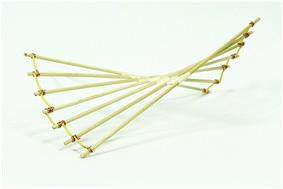当前位置:
X-MOL 学术
›
Soft Matter
›
论文详情
Our official English website, www.x-mol.net, welcomes your
feedback! (Note: you will need to create a separate account there.)
Anisotropic swelling of anisotropic elastic panels
Soft Matter ( IF 2.9 ) Pub Date : 2021-2-10 , DOI: 10.1039/d0sm01495h H. G. Wood 1, 2, 3 , J. A. Hanna 3, 4, 5, 6
Soft Matter ( IF 2.9 ) Pub Date : 2021-2-10 , DOI: 10.1039/d0sm01495h H. G. Wood 1, 2, 3 , J. A. Hanna 3, 4, 5, 6
Affiliation

|
While isotropic in-plane swelling problems for thin elastic sheets have been studied extensively in recent years, many shape-programmable materials, including nematic solids and 3D-printed structures, are anisotropic, as are most industrial sheet materials. In this theoretical work, we consider central swelling and shrinkage of plates of aspect ratio and material properties relevant to the manufacture of engineered wood composite panels in which both in-plane swelling and material stiffness are highly orthotropic, leading to multiple separations in energy scales. With transverse swelling in the soft direction, and gradients in the stiff direction, the warped plates adopt two distinct types of configurations, axisymmetric and twisted, which we illustrate with toy models. We employ a two-parameter family of isometries to embed the metric programmed by the swelling, thus reducing the problem to one of minimizing bending energy alone. A simple argument is seen to closely predict averaged axisymmetric curvatures. While purely cylindrical shapes are unobtainable by pure in-plane swelling, they can be closely approximated in a highly anisotropic system. However, anisotropy can favor twisting, and breaks a degenerate soft deformation mode associated with minimal surfaces in isotropic materials. Bifurcations from axisymmetric to twisted shapes can be induced by anisotropy or by certain attributes of a central shrinkage profile. Finally, we note how our findings indicate practical limitations on the diagnosis of moisture inhomogeneities in manufactured panels by observation of warped conformations, due to the sensitivity of the qualitative response to specifics of the profile.
中文翻译:

各向异性弹性板的各向异性溶胀
尽管近年来已广泛研究了薄弹性片材的各向同性面内膨胀问题,但与大多数工业片材一样,许多形状可编程材料(包括向列固体和3D打印结构)也是各向异性的。在这项理论工作中,我们考虑了纵横比和材料特性的板材的中心膨胀和收缩,而这些特性与人造木复合板的制造有关,其中,平面内膨胀和材料刚度都高度正交各向异性,从而导致能级多次分离。通过在软方向上的横向膨胀和在硬方向上的梯度,变形的板采用两种不同类型的配置,即轴对称和扭曲,我们用玩具模型进行了说明。我们采用等距的两参数族来嵌入通过膨胀编程的度量,从而将问题减少到仅使弯曲能量最小化的问题之一。可以看到一个简单的论据可以紧密预测平均的轴对称曲率。虽然无法通过纯粹的平面内溶胀获得纯粹的圆柱形状,但可以在高度各向异性的系统中近似地近似它们。但是,各向异性会有利于扭曲,并破坏与各向同性材料中最小表面相关的退化的软变形模式。从轴对称到扭曲形状的分叉可能是由各向异性或中心收缩曲线的某些属性引起的。最后,我们注意到我们的发现如何表明通过观察翘曲的构象来诊断人造板中水分不均匀性的实际局限性,
更新日期:2021-02-18
中文翻译:

各向异性弹性板的各向异性溶胀
尽管近年来已广泛研究了薄弹性片材的各向同性面内膨胀问题,但与大多数工业片材一样,许多形状可编程材料(包括向列固体和3D打印结构)也是各向异性的。在这项理论工作中,我们考虑了纵横比和材料特性的板材的中心膨胀和收缩,而这些特性与人造木复合板的制造有关,其中,平面内膨胀和材料刚度都高度正交各向异性,从而导致能级多次分离。通过在软方向上的横向膨胀和在硬方向上的梯度,变形的板采用两种不同类型的配置,即轴对称和扭曲,我们用玩具模型进行了说明。我们采用等距的两参数族来嵌入通过膨胀编程的度量,从而将问题减少到仅使弯曲能量最小化的问题之一。可以看到一个简单的论据可以紧密预测平均的轴对称曲率。虽然无法通过纯粹的平面内溶胀获得纯粹的圆柱形状,但可以在高度各向异性的系统中近似地近似它们。但是,各向异性会有利于扭曲,并破坏与各向同性材料中最小表面相关的退化的软变形模式。从轴对称到扭曲形状的分叉可能是由各向异性或中心收缩曲线的某些属性引起的。最后,我们注意到我们的发现如何表明通过观察翘曲的构象来诊断人造板中水分不均匀性的实际局限性,











































 京公网安备 11010802027423号
京公网安备 11010802027423号